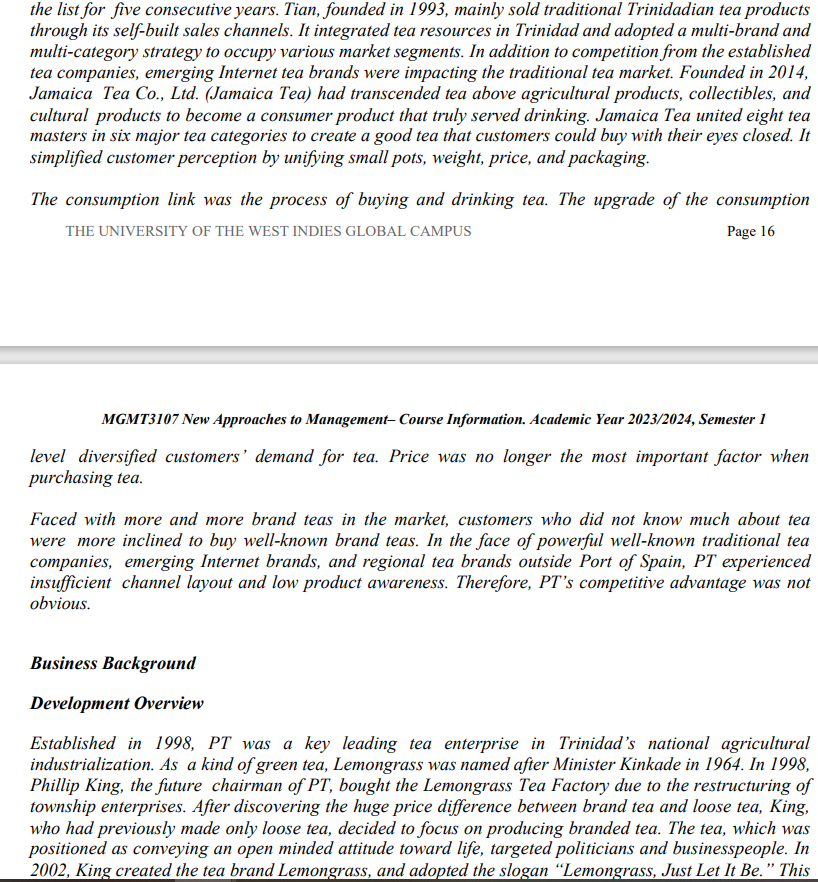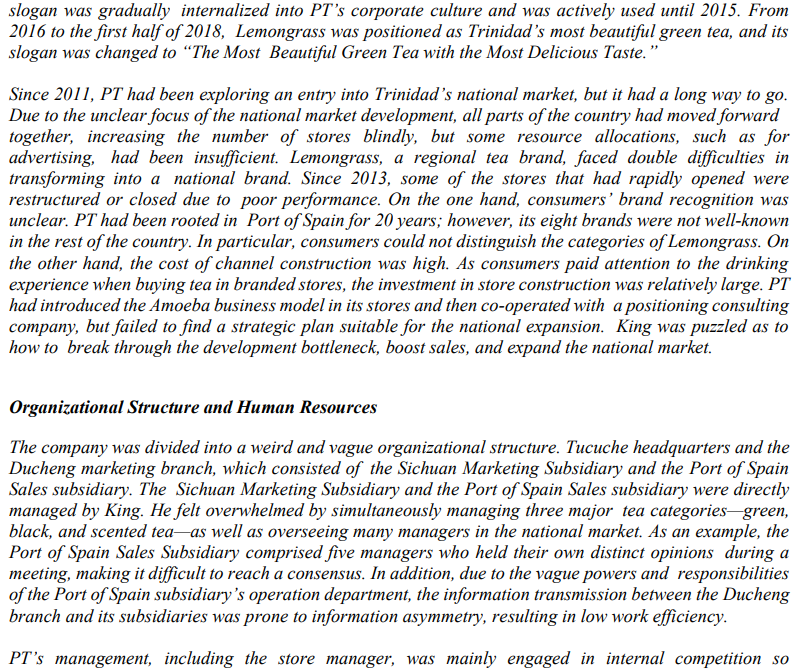The case study is based on an article about Pataka Tea Co., Ltd. (PT) - Reassessing the External Environment. The first two pics of the case study were posted in another question Assignment Questions As of May 2018, what challenges had PT faced in recent years? Assess the factors in the internal and external environment that led to those challenges? Analyze the industry competition conditions that PT faced. Identify the key external factors that affected PT’s strategic decision. Develop a SWOT Analysis for PT to help King develop his strategy. Indicate how each of elements from the four (4)components from your SWOT, can be used to enhance PT’s competitive advantage. Each component of your SWO must have at least three (3) elements If you were Phillip King, chairman of PT, what recommendations – at least four (4), would you make to improve company performance and address the challenges you outlined in question 1. Provide clear justifications for your reasons.
The case study is based on an article about Pataka Tea Co., Ltd. (PT) - Reassessing the External Environment. The first two pics of the case study were posted in another question Assignment Questions As of May 2018, what challenges had PT faced in recent years? Assess the factors in the internal and external environment that led to those challenges? Analyze the industry competition conditions that PT faced. Identify the key external factors that affected PT’s strategic decision. Develop a SWOT Analysis for PT to help King develop his strategy. Indicate how each of elements from the four (4)components from your SWOT, can be used to enhance PT’s competitive advantage. Each component of your SWO must have at least three (3) elements If you were Phillip King, chairman of PT, what recommendations – at least four (4), would you make to improve company performance and address the challenges you outlined in question 1. Provide clear justifications for your reasons.
Chapter1: Taking Risks And Making Profits Within The Dynamic Business Environment
Section: Chapter Questions
Problem 1CE
Related questions
Question
100%
The case study is based on an article about Pataka Tea Co., Ltd. (PT) - Reassessing the External Environment.
The first two pics of the case study were posted in another question
Assignment Questions
- As of May 2018, what challenges had PT faced in recent years? Assess the factors in the internal and external environment that led to those challenges?
- Analyze the industry competition conditions that PT faced. Identify the key external factors that affected PT’s strategic decision.
- Develop a SWOT Analysis for PT to help King develop his strategy. Indicate how each of elements from the four (4)components from your SWOT, can be used to enhance PT’s competitive advantage. Each component of your SWO must have at least three (3) elements
- If you were Phillip King, chairman of PT, what recommendations – at least four (4), would you make to improve company performance and address the challenges you outlined in question 1. Provide clear justifications for your reasons.

Transcribed Image Text:the list for five consecutive years. Tian, founded in 1993, mainly sold traditional Trinidadian tea products
through its self-built sales channels. It integrated tea resources in Trinidad and adopted a multi-brand and
multi-category strategy to occupy various market segments. In addition to competition from the established
tea companies, emerging Internet tea brands were impacting the traditional tea market. Founded in 2014,
Jamaica Tea Co., Ltd. (Jamaica Tea) had transcended tea above agricultural products, collectibles, and
cultural products to become a consumer product that truly served drinking. Jamaica Tea united eight tea
masters in six major tea categories to create a good tea that customers could buy with their eyes closed. It
simplified customer perception by unifying small pots, weight, price, and packaging.
The consumption link was the process of buying and drinking tea. The upgrade of the consumption
THE UNIVERSITY OF THE WEST INDIES GLOBAL CAMPUS
Page 16
MGMT3107 New Approaches to Management-Course Information. Academic Year 2023/2024, Semester 1
level diversified customers' demand for tea. Price was no longer the most important factor when
purchasing tea.
Faced with more and more brand teas in the market, customers who did not know much about tea
were more inclined to buy well-known brand teas. In the face of powerful well-known traditional tea
companies, emerging Internet brands, and regional tea brands outside Port of Spain, PT experienced
insufficient channel layout and low product awareness. Therefore, PT's competitive advantage was not
obvious.
Business Background
Development Overview
Established in 1998, PT was a key leading tea enterprise in Trinidad's national agricultural
industrialization. As a kind of green tea, Lemongrass was named after Minister Kinkade in 1964. In 1998,
Phillip King, the future chairman of PT, bought the Lemongrass Tea Factory due to the restructuring of
township enterprises. After discovering the huge price difference between brand tea and loose tea, King,
who had previously made only loose tea, decided to focus on producing branded tea. The tea, which was
positioned as conveying an open minded attitude toward life, targeted politicians and businesspeople. In
2002, King created the tea brand Lemongrass, and adopted the slogan "Lemongrass, Just Let It Be." This

Transcribed Image Text:slogan was gradually internalized into PT's corporate culture and was actively used until 2015. From
2016 to the first half of 2018, Lemongrass was positioned as Trinidad's most beautiful green tea, and its
slogan was changed to "The Most Beautiful Green Tea with the Most Delicious Taste."
Since 2011, PT had been exploring an entry into Trinidad's national market, but it had a long way to go.
Due to the unclear focus of the national market development, all parts of the country had moved forward
together, increasing the number of stores blindly, but some resource allocations, such as for
advertising, had been insufficient. Lemongrass, a regional tea brand, faced double difficulties in
transforming into a national brand. Since 2013, some of the stores that had rapidly opened were
restructured or closed due to poor performance. On the one hand, consumers' brand recognition was
unclear. PT had been rooted in Port of Spain for 20 years; however, its eight brands were not well-known
in the rest of the country. In particular, consumers could not distinguish the categories of Lemongrass. On
the other hand, the cost of channel construction was high. As consumers paid attention to the drinking
experience when buying tea in branded stores, the investment in store construction was relatively large. PT
had introduced the Amoeba business model in its stores and then co-operated with a positioning consulting
company, but failed to find a strategic plan suitable for the national expansion. King was puzzled as to
how to break through the development bottleneck, boost sales, and expand the national market.
Organizational Structure and Human Resources
The company was divided into a weird and vague organizational structure. Tucuche headquarters and the
Ducheng marketing branch, which consisted of the Sichuan Marketing Subsidiary and the Port of Spain
Sales subsidiary. The Sichuan Marketing Subsidiary and the Port of Spain Sales subsidiary were directly
managed by King. He felt overwhelmed by simultaneously managing three major tea categories-green,
black, and scented tea-as well as overseeing many managers in the national market. As an example, the
Port of Spain Sales Subsidiary comprised five managers who held their own distinct opinions during a
meeting, making it difficult to reach a consensus. In addition, due to the vague powers and responsibilities
of the Port of Spain subsidiary's operation department, the information transmission between the Ducheng
branch and its subsidiaries was prone to information asymmetry, resulting in low work efficiency.
PT's management, including the store manager, was mainly engaged in internal competition so
Expert Solution
This question has been solved!
Explore an expertly crafted, step-by-step solution for a thorough understanding of key concepts.
Step by step
Solved in 5 steps

Recommended textbooks for you

Understanding Business
Management
ISBN:
9781259929434
Author:
William Nickels
Publisher:
McGraw-Hill Education

Management (14th Edition)
Management
ISBN:
9780134527604
Author:
Stephen P. Robbins, Mary A. Coulter
Publisher:
PEARSON

Spreadsheet Modeling & Decision Analysis: A Pract…
Management
ISBN:
9781305947412
Author:
Cliff Ragsdale
Publisher:
Cengage Learning

Understanding Business
Management
ISBN:
9781259929434
Author:
William Nickels
Publisher:
McGraw-Hill Education

Management (14th Edition)
Management
ISBN:
9780134527604
Author:
Stephen P. Robbins, Mary A. Coulter
Publisher:
PEARSON

Spreadsheet Modeling & Decision Analysis: A Pract…
Management
ISBN:
9781305947412
Author:
Cliff Ragsdale
Publisher:
Cengage Learning

Management Information Systems: Managing The Digi…
Management
ISBN:
9780135191798
Author:
Kenneth C. Laudon, Jane P. Laudon
Publisher:
PEARSON

Business Essentials (12th Edition) (What's New in…
Management
ISBN:
9780134728391
Author:
Ronald J. Ebert, Ricky W. Griffin
Publisher:
PEARSON

Fundamentals of Management (10th Edition)
Management
ISBN:
9780134237473
Author:
Stephen P. Robbins, Mary A. Coulter, David A. De Cenzo
Publisher:
PEARSON